Vintage Inspired Jewelry Design – Past Meets Present
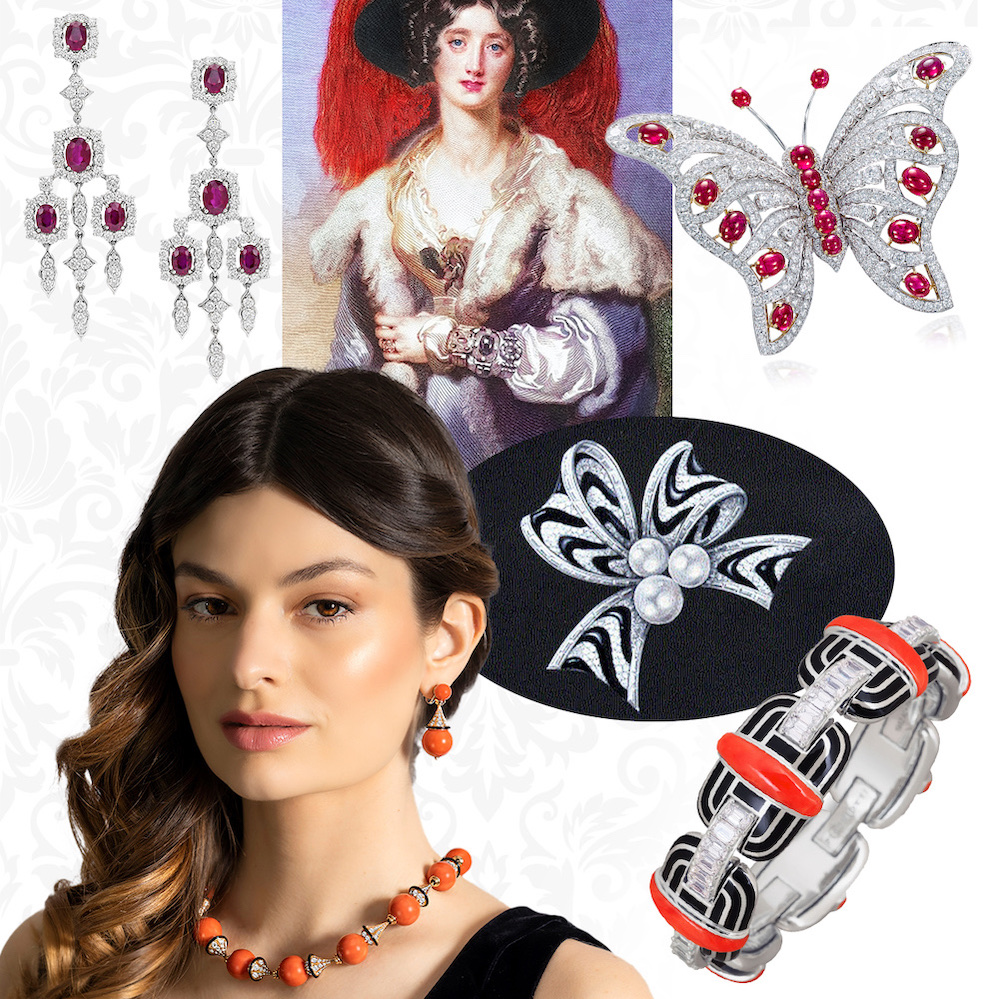
With all the period dramas on television and in the movies in the last few years, there is a renewed interest in vintage inspired jewelry. Younger generations are discovering iconic historical fashion and jewelry in shows like The Crown, Bridgerton, Queen Charlotte, and Downton Abbey, as well as films like The Favourite, Lady Chatterly’s Lover, and the soon to be released Napoleon. Each of these have inspired new audiences and created fresh demand for contemporary classics, jewelry styles that look to the past for inspiration, design, and recognizable motifs. Here we will explore a few of the well-known eras of jewelry history or specific designs and show some modern interpretations of each.
According to Giuseppe Picchiotti, Founder and lead designer of PICCHIOTTI, “One of our primary design inspirations at PICCHIOTTI is architecture. We are surrounded by beauty and a rich cultural history here in Italy, and we often look up, viewing the past through the lens of the present to create beloved jewelry classics the will endure well into the future.”
Baroque Era (1601 – 1700) – Bows, Flowers, Natural Pearls
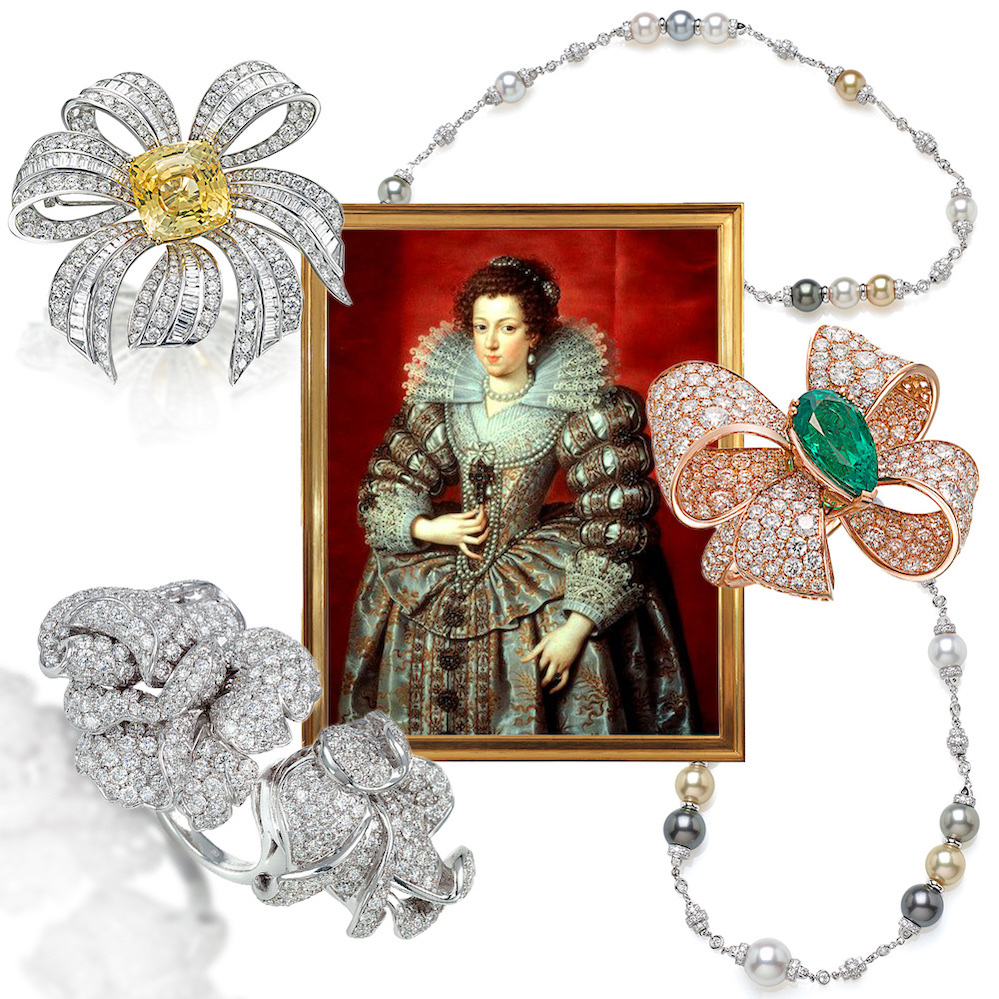
Clockwise from upper left – PICCHIOTTI Bow brooch with center fancy yellow diamond, PICCHIOTTI long necklace with multi-color pearls and diamonds, PICCHIOTTI Fiocco (Bow) ring in rose gold, diamond, and emerald, PICCHIOTTI Rose Garden diamond floral bracelet, Ana of Austria by Frans the Younger 1616, The Netherlands (Getty)
The term baroque typically refers to decorative arts and certain style motifs that emerged during the late Renaissance and after. However, things that were popular during the baroque era occasionally retain the name, for example “baroque” (or non-round) pearls are so named because they were first popularized in this time period. All pearls in the 17th century were natural and very rare, reserved for royalty and people of great status. The Gemological Institute of America (GIA) identifies the Baroque period as dating between 1601 – 1700 (basically, the 17th century). Bows were a prominent motif, seen in portraits, decorative arts, design, and fine jewelry. “The prevalence of the bow in this period may be traced to the practice of using a ribbon to secure ceremonial military medals of honor to uniforms and to pin elaborate gold jewelry to dark, royal robes.”
The Jewellery Editor traces the bow motif specifically to the French royal court of Louis XIV (1643 – 1715) where bows were symbols of love and marriage. Precious metals like gold and silver were fashioned into delicate double bows covered with gemstones and attached to necklaces or brooches. “In an era when emotions were rarely expressed, the wearing of bow jewelry was highly significant – a bow pendant worn on a ribbon around the neck conveyed a playful side, while a bow-shaped brooch pinned near the heart was a sign of being in love.”
For fans of bows, PICCHIOTTI has an entire collection devoted to the beloved motif. The Fiocco (bow in Italian) collection features a lovely array of bow rings, earrings, and necklaces fashioned in 18K white gold with diamonds and precious gemstones. Evolving from all-white styles to more colorful bows, the collection offers connoisseurs exciting options. Diamond ribbons ripple, loop, and twist effortlessly into charming bows. The center of the bow’s knot is often represented by a superlative gemstone – a spectacular drop shaped emerald, a deep red oval rubellite, or a stunning cabochon tanzanite.
Pearls were also prevalent in the 17th century, especially for royalty and nobility. In portraits from the Baroque era, parures of pearl jewelry were common. A parure is a set of jewelry that is intended to be worn together. Pearls from this era can be seen in many styles – short necklaces, drop earrings, a strand of pearls in the hair or brooches on bodices. Pearls were a refined status symbol for members of the nobility in Europe. PICCHIOTTI uses the precious luster of pearls to add a sense of sophistication to diamond jewels. Multiple colors of pearls are featured in the long diamond chain with three pearl stations in white, golden, and Tahitian pearls. A large and impressive South Sea white pearl is the center of a PICCHIOTTI diamond cocktail ring, and a choker length necklace featuring diamonds and large multicolor pearls looks like a modern interpretation of a necklace worn by a character from Bridgerton or Queen Charlotte.
For those who love naturalism in flowers, thank the Baroque era. As trade routes opened up with the advancement of travel in the 17th century, the flower trade in Europe blossomed. Naturalism in flowers began to appear. Once reserved for embroidery, flowers were now being adopted by jewelers. To this day, jewelry designers welcome the challenge of artfully rendering beautiful floral motifs. PICCHIOTTI’s beloved Rose Garden collection started with Giuseppe Picchiotti’s iconic Rose Brooch which he masterfully crafted in white diamonds in 1967 when he first started the PICCHIOTTI brand.
Victorian (1837 – 1901) and Edwardian (1901 – 1915) Periods – Nature, Ribbons, Swirls, Platinum
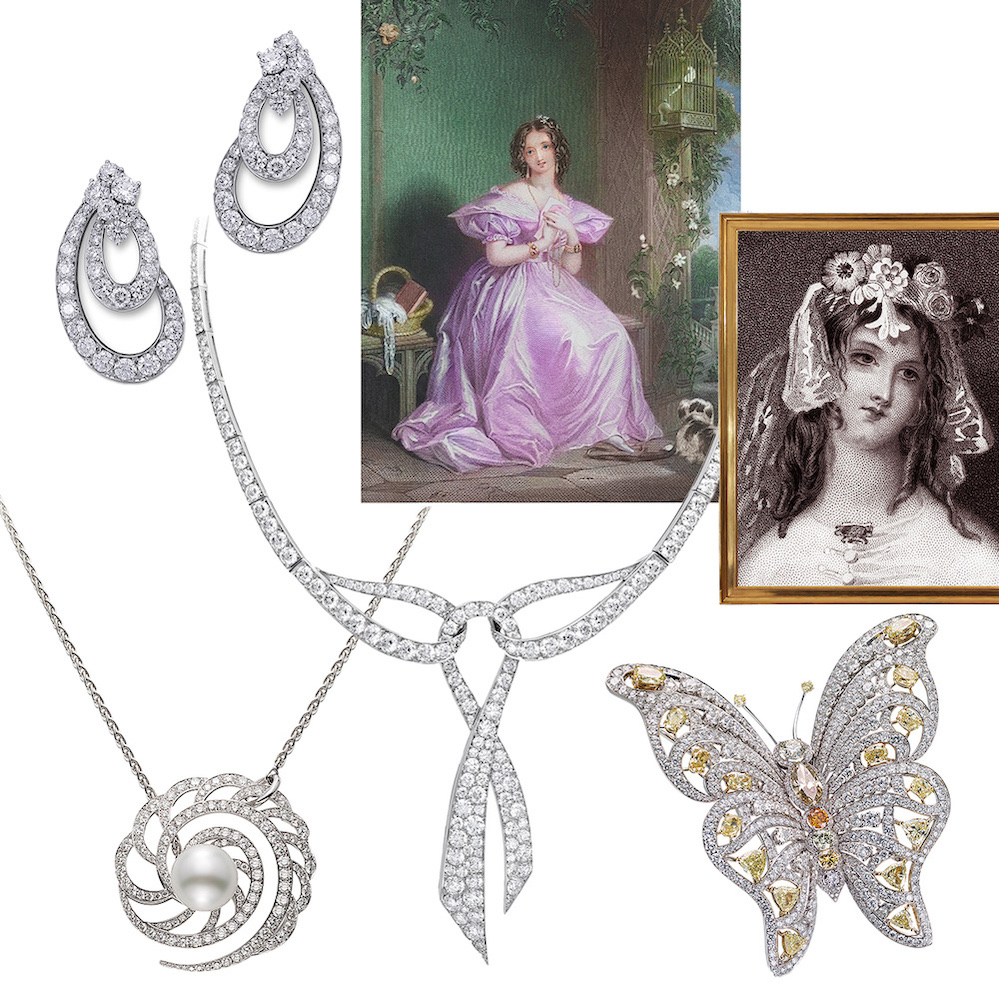
Clockwise from upper left – PICCHIOTTI swirl diamond earrings, engraved illustration of “The Proposal” by E. T. Parris (Getty), Francesca Foscari by Joseph Kenny Meadows (Getty), PICCHIOTTI Butterfly brooch, PICCHIOTTI Fiocco collection ribbon necklace, PICCHIOTTI swirl and pearl pendant necklace
The Victorian era takes its name from the British monarch Queen Victoria who reigned for 63 years in the 1800s or the 19th century. Given the boom in urbanization during this time, nature became highly prioritized, in the home and in fashion and fine jewelry. Early Victorian jewels were often floral designs, but later jewelry craftsmen branched out to include insects like butterflies and dragonflies, as well as spiders, beetles/scarabs, bees, and flies. PICCHIOTTI’s butterfly brooches re-interpret one of nature’s most beloved insects with the playful dance of colorful gemstones.
The Edwardian era was during the reign of King Edward VII who ruled a short nine years from 1901 to 1910. It is the last of the jewelry periods to be named for a British monarch. The era is also known as “La Belle Époque” and the jewelry from this time incorporates filigree and open work, as well as ornate flowery designs, more intricate than those seen in the Victorian era. Curved lines were popular, including loops, scrolls, garlands, ribbons, and bows. The introduction of platinum into jewelry design made it possible to render lace, bow knots, and tassels with a new lightness. According to Antique Jewelry University, “In 1903 the invention of the oxyacetylene torch, which could reach the temperatures necessary to work with platinum, allowed jewelry to be made solely from platinum. The strength of platinum was fully exploited, and it became possible to create jewels that resembled ‘petit point’ embroidery and fine, delicate, sophisticated jewels resembling diamond-encrusted lace.”
Some of PICCHIOTTI’s Fiocco pieces embrace that fluidity of fabric. The Fiocco necklace features ribbons that fold joyfully over one another in a tied fashion that resembles how a scarf is often worn around the neck. The all-white diamonds set in 18K white gold give the piece a subtle elegance, at once both understated and sophisticated. The coiled hoop of PICCHIOTTI’s Hoops pearl pendant necklace has an undulating Edwardian influence. The dominant white pearl at the center of the matching earring brings a hint of regal grace to the look, definitely a modern style but with hints of curves, loops, and scrolls seen in Edwardian jewelry.
Girandole – Spanning 17th to 18th Centuries
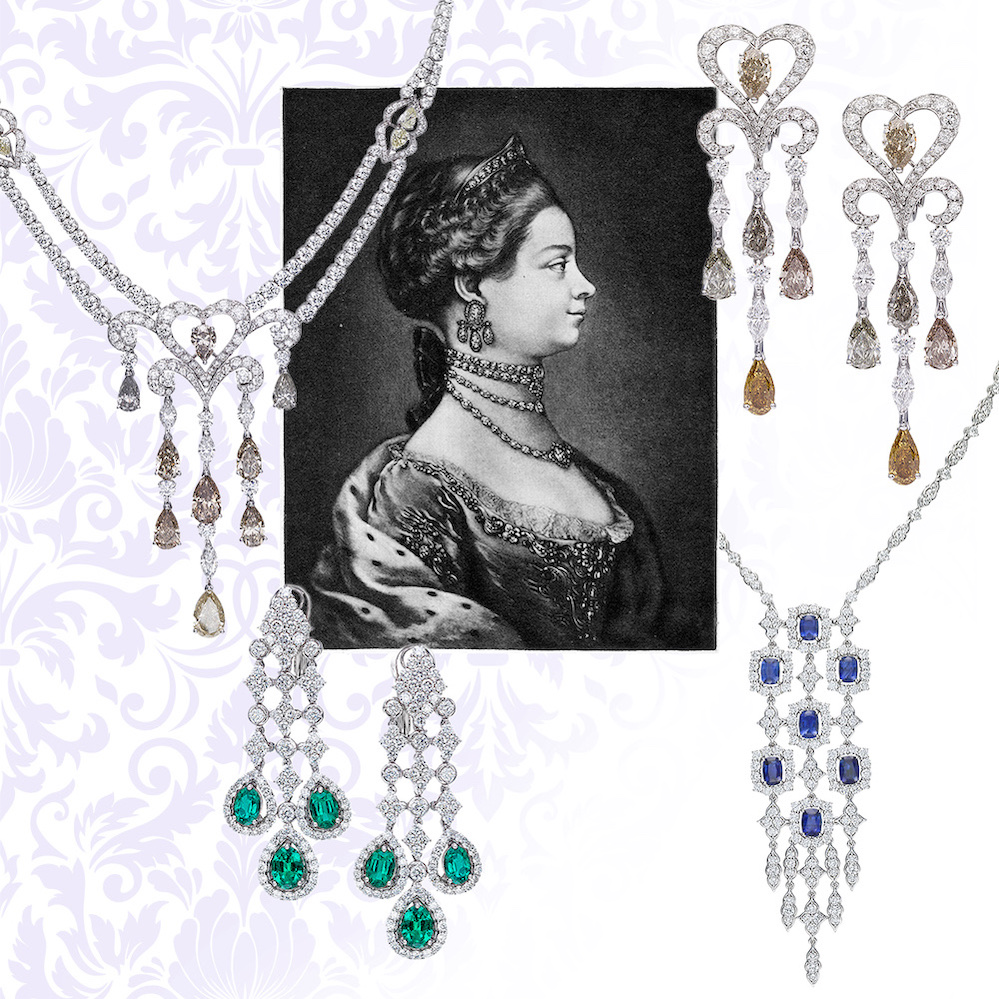
Clockwise from upper left – PICCHIOTTI Chandelier necklace in white and yellow diamonds, Portrait of Queen Charlotte (Getty), PICCHIOTTI Chandelier earrings in yellow and white diamonds, PICCHIOTTI Chandelier necklace in diamonds and sapphires, PICCHIOTTI Chandelier earrings in diamonds and emeralds
A girandole is a design with three dangling pear-shaped ornaments suspended from a central motif, usually a bow. Popular for hundreds of years, spanning the 17th and 18th centuries, the girandole earring was the most typical and well-known earring type of the late 17th century, according to Antique Jewelry University. Girandole designs were produced with a wide variety of gemstones. Eventually, the look evolved into pendants and brooches, as well.
Many of PICCHIOTTI’s Chandelier styles owe their inspiration to the classic girandole. The yellow drop diamond Chandeliers feature three tiered drops culminating in a yellow diamond, each suspended from swirls beneath a diamond heart. A similar expanded style is featured in the Chandelier necklace to stunning effect – this design could easily have been used in any number of the popular period dramas of late. The emerald chandelier earring minimizes the central motif at top and features three gorgeous pear-shaped emeralds dangling from long white diamond drops. Without a fancy bow or loop at top, the focus is clearly on the tiered emeralds, as PICCHIOTTI is known for its superlative colored gemstones. The PICCHIOTTI ruby chandelier earrings invert the gemstones and the diamonds, with white diamond drops hanging beneath the triad of rubies, a fresh take on the girandole design. Similarly, the sapphire chandelier necklace features diamonds beneath the blue sapphires but in an elongated style. The effect feels both modern and vintage, a gentle nod to the past in a classic and contemporary design. Many of these styles are reminiscent of the jewelry seen in The Favourite and Queen Charlotte or Bridgerton.
Art Nouveau 1890 – 1910 – Asymmetry, Nature, Draping
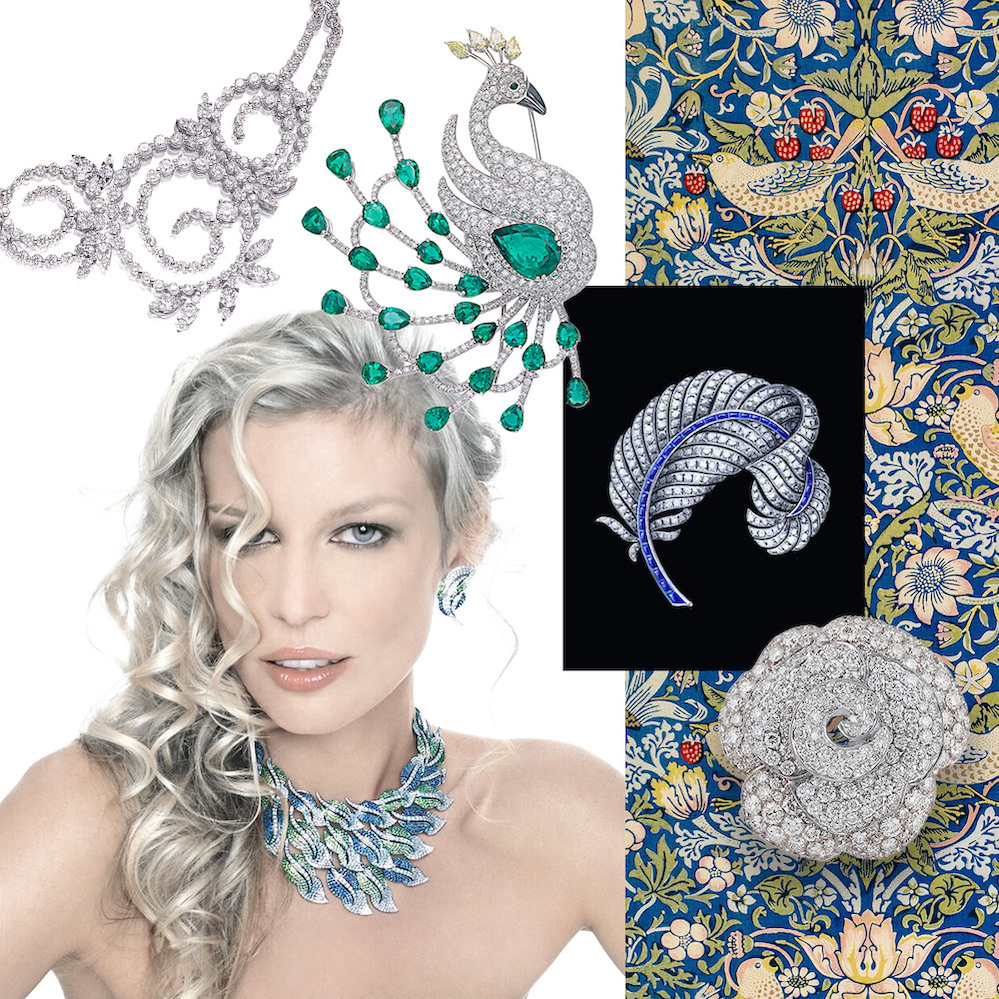
Clockwise from upper left – The Curls necklace by PICCHIOTTI, PICCHIOTTI Masterpieces emerald peacock brooch, Art Nouveau pattern by William Morris (Getty), PICCHIOTTI feather brooch in sapphires and diamonds, PICCHIOTTI Rose Garden diamond ring, model wearing PICCHIOTTI Leaves necklace and earrings
The turn of the century ushered in the Art Nouveau era which overlaps with the Edwardian era. But the style of Art Nouveau was quite distinct, featuring draping and flowery designs, along with a preference for organic structures and a lack of symmetry. Often inspired by nature, Art Nouveau creators of note include the famous René Lalique. Intricate carvings of butterfly wings, birds, and floral motifs are hallmarks of Lalique style. Some of the famous PICCHIOTTI bird brooches are reminiscent of this style, as well. The PICCHIOTTI Masterpieces peacock brooch featured intricately carved diamond feathers and an emerald studded peacock train. According to jewelry historian, author, curator and co-director of the Association for the Study of Jewelry and Related Arts (ASJRA) Elyse Karlin, “the peacock was a ubiquitous symbol in Art Nouveau…as well as in the Arts and Crafts Movement. It symbolized renewal and pride.”
The PICCHIOTTI leaf pieces and feather brooches from the brand’s fourth decade also have an Art Nouveau feel, in their draping furls and asymmetrical styling. Leaves, as well as flowers and animals, especially feathered birds, are one of the most successful assortments of PICCHIOTTI’s one-of-a-kind jewels. The brand has been “bringing nature to life” since its inception in 1967, utilizing PICCHIOTTI’s incredible talent to reproduce the complex and intricate beauty found in nature. For more on the brand’s unique sculpting of natural forms, read our blog post on Nature Inspired Jewelry here.
The PICCHIOTTI Curls necklace owes its design inspiration to the early part of the 20th century, as well. The swirling diamond loops are a nod to La Belle Époque and Art Nouveau jewelry. This ultra-feminine necklace is a PICCHIOTTI Masterpiece, crafted in round diamonds with a subtle glamour. It is the perfect example of taking a hint from the past to create a classic and beautiful design that will stand the test of time. The necklace was created with matching earrings, as well, with sparkle that looked particularly striking worn high on the lobe and close to the face.
Art Deco 1920 – 1945
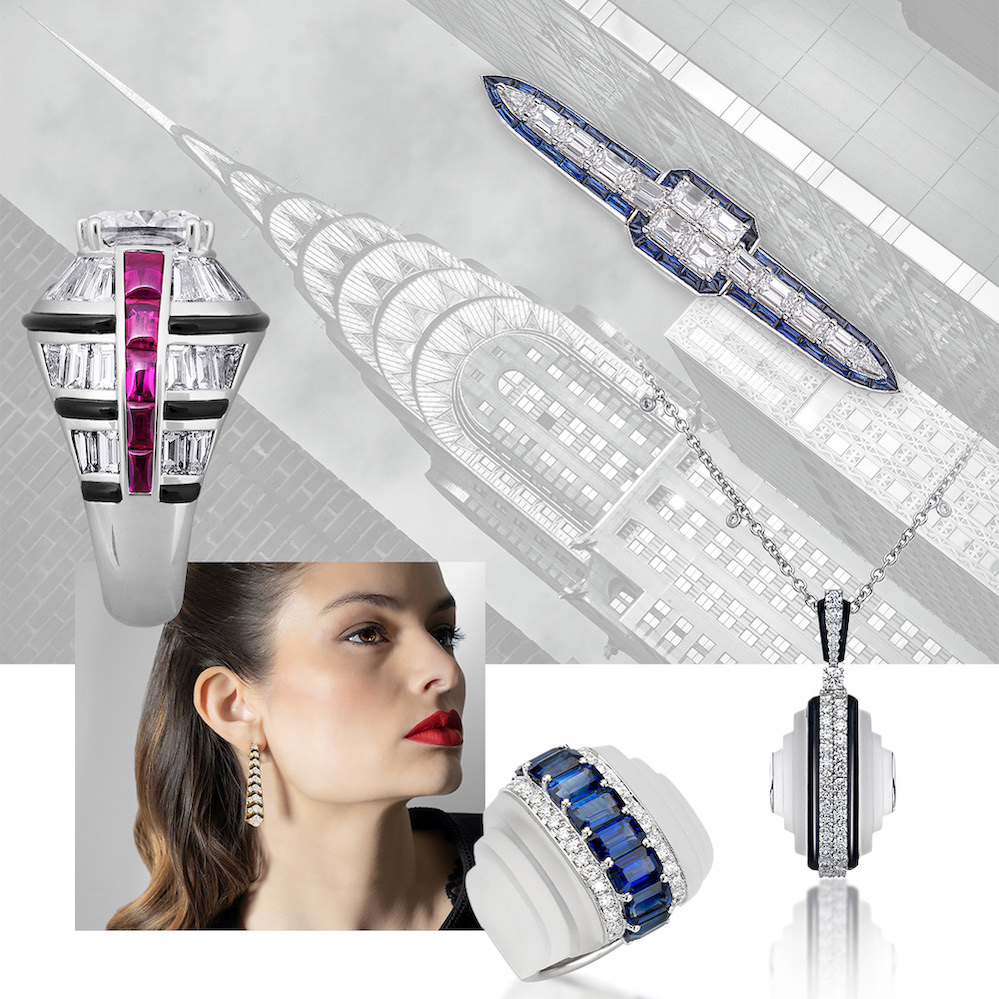
Clockwise from upper right – PICCHIOTTI sapphire and diamond brooch, PICCHIOTTI Art Deco onyx, diamond, and rock crystal pendant necklace, PICCHIOTTI sapphire, diamond, and rock crystal Art Deco ring, model wearing PICCHIOTTI Essentially Color Art Deco inspired earrings, PICCHIOTTI Masterpieces Art Deco diamond ring with rubies and onyx
One of PICCHIOTTI’s most beloved jewelry styles and big inspiration in many of its current designs is Art Deco. The Art Deco period historically dates between 1920 and 1945. Following World War I and the Parisian Exposition Internationale des Art Décoratifs and Industries Moderne entitled “1925 Expo – Art Deco,” the design, architecture, and jewelry from this time period is known for its geometric shapes and an angular, clean look. Many landmark buildings, such as the Empire State Building in New York City, are iconic examples of Art Deco architecture. Jewelry designed with Art Deco in mind is also very streamlined, symmetrical, and geometric. PICCHIOTTI’s “Essentially Color” earrings in Onyx and Diamond are the perfect example of a modern Art Deco interpretation. The concentric triangle/pyramid shapes are linear and graduated, creating a long angular drop earring in classic black, white, and gold colors.
Juxtaposition of contrasting colors was also prevalent in Art Deco design. The PICCHIOTTI Gem Ceramics bracelet (see feature image above) is a great example. The black ceramic “lines” that make up the squares of the bracelet surround the perpendicular red strips of coral. The bands of emerald cut diamonds connect the “links,” leading the eye directly to the contrast between the vibrant coral and the dark onyx. A similar matching gem ceramic ring has a shank of perfectly stair-stepped black onyx leading up to the central attraction – the large radiant cut square diamond center is flanked by bullet cut diamonds and the bright hue of the Mediterranean Coral. The stylized lines around both the ring and the bracelet bring to mind the famous Chrysler Building in Manhattan, another beloved Art Deco landmark.
The flanked cut of the rock crystal in PICCHIOTTI’s sapphire, diamond, and rock crystal ring, as well as the tiered stripes of the diamond and onyx pendant necklace, are both flattering nods to the Empire State Building’s upper tiers. The emerald cut shapes of the Sapphires add to the overall geometric appeal of the design. The Masterpieces Diamond ring is a celebration of angular style and Art Deco glory.
The Baguette-Cut diamond also arrived on the scene during the Art Deco era. According to jewelry historian Vivienne Becker, the new diamond shape (the baguette) was made possible by improved cutting techniques and a better understanding of optics and how light plays within a diamond. Becker explains how baguettes became “a defining feature of 1920s jewelry and the perfect expression of cubist-inspired, machine-age modernism.” Today, PICCHIOTTI uses the baguette-cut diamond as a signature motif of its unique design vocabulary. They often give an Art Deco feel to many PICCHIOTTI designs. Lovers of baguette diamonds should read our blog post on The Baguette-Cut Diamond and the Creation of a Signature Style.
Even modern engagement rings and bridal earrings can be influenced by the geometry of Art Deco. PICCHIOTTI offers a stunning bridal ring with a large cushion cut center diamond haloed in an octagonal shape by two rows of precisely re-cut baguette diamonds. A similar pair of earrings feature a halo of baguettes around a radiant cut center diamond and a graduated vertical strip of baguettes that travel slightly down the lobe.
A simple linear motif of a diamond and sapphire brooch can also pay homage to the angular and geometric forms of Art Deco. None of these designs are truly vintage, but it is easy to see how Art Deco continues to inspire jewelry design to this day.
Another element of Art Deco is color. The Art Deco decorative arts rely heavily on bold splashes of color and as mentioned above, the use of contrasting colors. PICCHIOTTI’s coral necklace and earrings bring bold spheres of Mediterranean coral (see feature image above) into classic alignment with the use of black onyx strips and conical rose gold elements that accentuate the geometric form of the coral beads.
For those who love the many cultural references to historic fashions and especially fine jewelry, vintage inspired jewelry can become fun to collect and own. Vintage jewelry itself is charming and certainly worthy of a treasure hunt, but contemporary jewelry, like many of the PICCHIOTTI styles mentioned above, can also capture the essence of a particular historic period. At PICCHIOTTI, we love the nobility and sophistication of jewelry from bygone eras, and we are grateful for the many vintage inspirations that make our designs all the more beautiful and meaningful. This is one of the primary reasons that we focus on a classic aesthetic as part of our brand signature. Good design transcends time. The girandole style, for example, can feel just as relevant now as it did hundreds of years ago. Refining the best of what the past has to offer and bringing it forward into the future – that is the challenge our designers tackle every day. Explore more exciting PICCHIOTTI jewelry styles on PICCHIOTTI.com.
Feature image at top – clockwise from upper right – PICCHIOTTI butterfly brooch in white diamonds and rubies, design sketch of a PICCHIOTTI bow brooch with diamonds, onyx, and pearls, PICCHIOTTI Gem Ceramic Art Deco bracelet, model wearing the Essentially Color Coral necklace and matching earrings, PICCHIOTTI Chandelier diamond and ruby earrings, Portrait of Julia Floyd by Sir Thomas Lawrence (Getty)
If you liked this, you might also like…
The Baguette-Cut Diamond and the Creation of a Signature Style
Nature Inspired Jewelry – Sculpting Gems True to Life
Italian Jewelry – A Heritage of Gold Craftsmanship in Valenza


